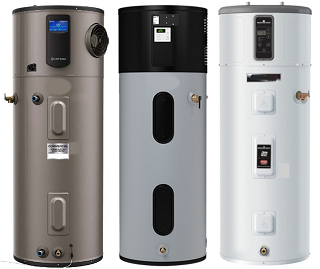
|
Did you know that water heating is the second-largest source of home energy use after HVAC? Taking hot showers, doing laundry, and washing dishes can really rack up both the BTUs and the bills. Unfortunately, 53 percent of residential buildings in the U.S. rely on fossil fuels to heat all that water (as of 2020). That’s a whole lot of natural gas, propane, and fuel oil being combusted. The remaining 47 percent of water heaters are mostly electric resistance (ERWHs). ERWHs are cleaner than their fossil-fueled counterparts (no onsite emissions). However, their energy factors, i.e., efficiency, max out around 0.95. This makes them costly to operate in states with expensive electricity. Heat pump water heaters (HPWHs), on the other hand, are both clean and highly efficient. Because they’re powered by electricity, they too produce no onsite emissions. What’s more, they boast energy factors between 2 and 3, over 200 to 300 percent more efficient than ERWHs! How Do They Work? Heat pump water heaters, like other heat pumps, draw heat from the surrounding air rather than producing it through combustion or electric resistance. But instead of blowing that heat through the rest of the room like a regular heat pump, they channel it into coils wrapped around a water tank. The coils, which are full of a low boiling point refrigerant, heat the water in the tank to the temperature set on the control panel. You might have heard HPWHs referred to as “hybrid” water heaters. That’s because most HPWHs have backup electric resistance (ER) heating built in. The ER element kicks in if the heat pump can’t keep up with hot water demand; for instance, when two people are showering at once and the dishwasher is running. Or maybe it’s just too cold in the room where the heat pump is installed (HPWHs function best in rooms that stay at or above 50 degrees Fahrenheit). Heat Pump Water Heaters: A Brief History It might surprise you that heat pump water heaters are not new. Like electric vehicles, HPWHs were pioneered many decades ago – 1935 to be precise. However, it wasn’t until the 1980s that the technology gained any real market share with over 10,000 sales annually. Yet before too long, this early surge crested and fell due to high costs and poor reliability. In 2010, the U.S. Department of Energy (DOE) breathed new life into the HPWH market. The DOE mandated that all newly installed electric water heaters on or after April 16, 2015, must have energy factors around 2 (or more). Because it’s impossible for ERWHs to meet that standard, HPWHs became the default for electric water heating, forcing manufacturers to adapt. Since DOE’s mandate, we’ve seen a proliferation of available HPWH models from companies like Rheem, A.O. Smith, and GE. 120V Heat Pump Water Heaters – And Why They Matter Like air source heat pumps, HPWHs do have some downsides: namely cost and requisite electrical infrastructure. If a property owner has a gas-powered water heater in place and wants to switch to a HPWH, they might not have adequate space on their electric panel or a spare 240-volt outlet. So, in addition to the $1,200 – $2,500 for the appliance itself, electrical upgrades could tack on hundreds, if not thousands, more. Luckily, this past summer, Rheem released the first-ever 120-volt HPWH: the ProTerra Plugin. Now, homeowners who want to switch to electric water heating can do so without forking over all that extra cash. You just need a standard outlet and some piping! It’s important to note that the ProTerra Plugin doesn’t have electric resistance backup. But for homes with smaller hot water needs, it should work just fine. And for households across the country, rebate programs and new tax credits borne from Inflation Reduction Act will help bring down upfront costs for both the hardware and any required electrical upgrades. Check out our federal dashboard to learn more! |
|
|
|



